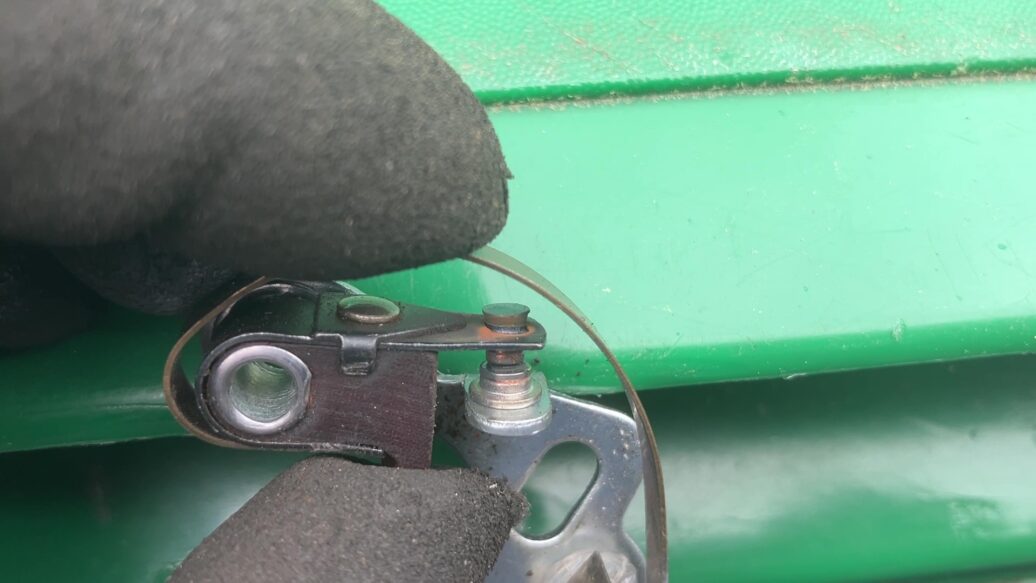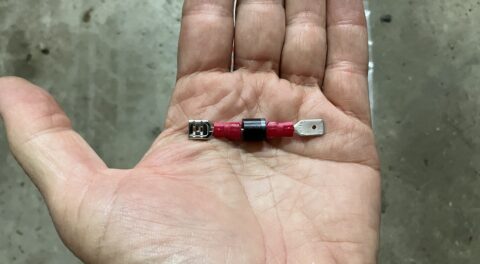I’d hoped to write this week about replacing the E39’s power steering pump, but life intervened, so instead, you’re going to get another chapter from my upcoming thousand-page novel, “Points Versus Pertronix.”
For years, I’ve been writing about how ignition problems and fuel delivery issues are the most common thing to cause you to go in a few seconds from livin’ the dream in your vintage BMW to dead in the breakdown lane. On the ignition side, that’s usually due to the points closing up. In the good old days, that was either because the points gradually became pitted, or the nylon block riding on the distributor shaft’s cam lobes gradually wore down, or both. When that happened, you could pull out your 0.016″ feeler gauge (or a matchbook), reset the point gap, be on your way, and forever impress whoever you were traveling with. But with the shockingly poor quality of new vintage ignition parts these days, ignition failure can be because the nylon block simply snapped off the points, in which case if you don’t have a spare set with you, you’re boned. Combine this with the points’ perpetual companion, the condenser, having the same quality control issues, and you’re at high risk for a suddenly-dead car. I’m not a pro, but I have friends who are, and the stories I hear about cars with fresh tune-ups using new Bosch points and condensers, sometimes in BMW boxes, that suddenly die and are rescued by pulling the old parts out of the trash or from a crevice in the trunk, never seem to cease.
As I’ve written many times, the solution to this is to replace the points and condenser with an electronic ignition module such as a Pertronix. Not only does this solve both the longstanding issue of points naturally closing up over time as well as the modern issue of sudden death from poor parts quality, but it also addresses the issue that when point gap changes, it changes the timing.
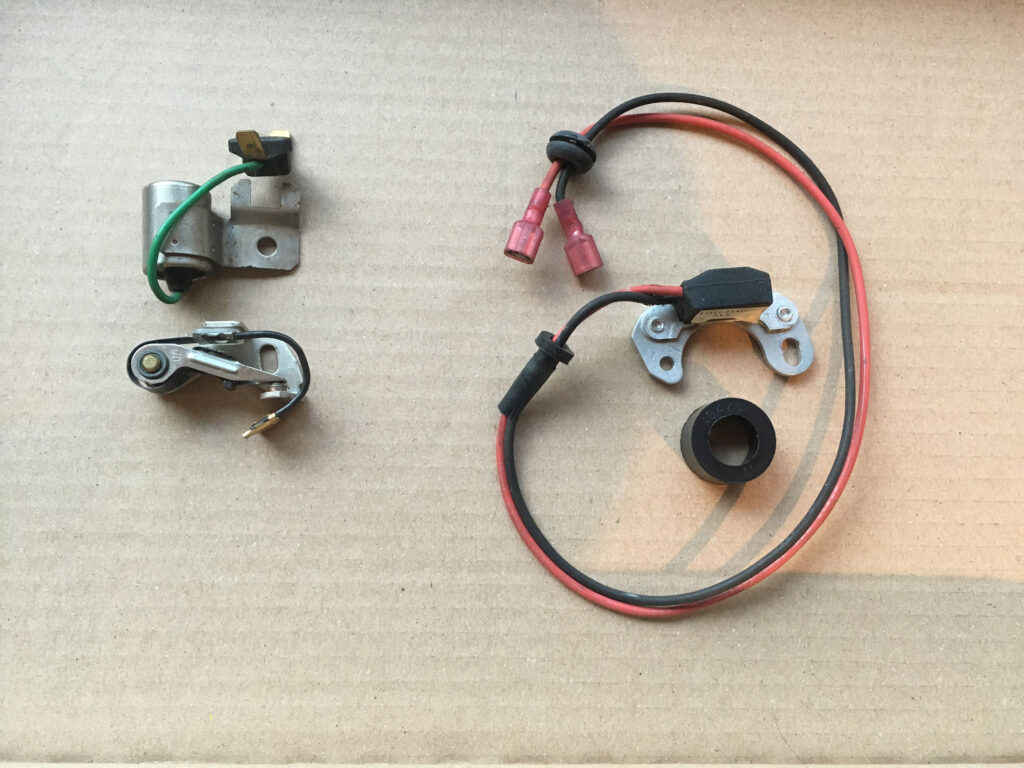
Points versus Pertronix. A debate as old as good versus evil. Or at least as Coke versus Pepsi.
When people poo-poo Pertronix by saying “It’s a black box, if it dies you can’t fix it, only replace it,” I say “How is that different from a bad condenser?” When they say “If you use Pertronix, you need to have a spare set of points in the trunk in case it dies,” I say “Like you don’t travel with a spare set of points anyway.” And when they say “I had a Pertronix, and it died,” I ask “Was it a real branded Pertronix or some brand-X triggering module? And did you install it correctly?”
The only times I’ve ever had them die were entirely my fault. The first was when I accidentally swapped the negative and positive leads to the coil which blew it up immediately. The second was when I didn’t pay attention to the printed instructions that say you need at least 3 ohms of series resistance between the coil and ballast resistor (e.g., with a Bosch Blue coil, there’s no need for a resistor, but if you run a Pertronix off a Bosch Red or Black coil with no ballast resistor, the additional current will fry it). Other than that, I’ve logged tens of thousands of miles on them without a hiccup, something I certainly can’t say about points and condensers.
The electronic distributor from 123 Ignition has become wildly popular in the vintage car world. To be absolutely clear about the difference between it and a $100-ish Pertronix triggering module, the Pertronix replaces the points and condenser in your existing mechanical advance distributor with a little electronic triggering module and a spinning magnetic ring. If your distributor has jittery advance, or if it’s not advancing at all with increasing engine RPM, the Pertronix isn’t going to fix it. In contrast, a 123 distributor is an entirely new unit with both electronic triggering and electronic advance with different levels of programmability depending on which one you buy. Folks who have them seem to love them. I’ve never bought one, as I always seem to find other uses for my $525-$650. If you have a dizzy with non-functional or jittery advance, Pertronix does also make a drop-in distributor, but they’re traditional mechanical advance units. They also cost a small fraction what you’d pay for a 123. I have one in my Lotus Europa.
So, with all that as the backdrop, here’s my latest “Why all new vintage ignition parts are crap” story. You’ll forgive me if it’s about my ’69 Lotus Elan +2 instead of a 2002, but I don’t think any of my vintage BMWs use points anymore.
As I wrote about here, I bought the Elan +2 last fall from the estate of the deceased owner. It was running, but hadn’t been used in several years (I assumed due to the owner’s failing health) and needed sorting out. One of the odd things about it was that it had a full Pertronix ignition system (Pertronix distributor and matching coil) sitting unused in a box due to some undiagnosed problem. Instead, what was in the car was a brand-new reproduction of the original Lucas distributor along with accompanying new points, condenser, cap, and rotor. The previous owner’s best friend—who was also the guy who’d restored the car—had installed it as part of getting the car running well enough to sell.
After a bunch of basic sort-out work over the fall, winter, and spring, I began driving ever-wider circles around my neighborhood in the car, and entered the “livin’ the dream” phase where you’re no longer afraid that it’s about to die at any moment. As with the Europa, the Elan +2 is an absolute delight on narrow twisty roads. These are the sort of cars where, if you’re driving at 42mph in a 35 zone, you feel like you should be arrested for having so much fun.
One of my pleasure-drive routes takes me west on a road with a route number, then meandering north through leafy towns, then east on Rt 2 to I-95 south and then home. In late May, as I approached I-95, I decided to return to the slower speeds and shade of the smaller roads and head home through Lincoln. Good thing, too, because within a mile, the car began stumbling and losing power, then died.

Lincoln was a lovely bucolic place to deal with a dead Lotus. I was literally in front of a horse farm.
Nearly all car-dies-while-running problems are due either to loss of fuel or loss of spark. It’s long been said that if a car feels like it’s running out of gas, it probably is, and it’s likely due to a bad fuel pump, a clogged fuel filter, or other delivery issue. If it’s a clogged filter, simply waiting a few minutes may allow the particulate matter to slide off the filter’s screen, and the car may then run for a bit until the fuel pressure clogs the screen up with sediment again. In contrast, ignition issues are often binary—the car suddenly dies, and doesn’t resurrect itself. If that’s not enough to tell which is which, a can of starting fluid is a very handy diagnostic tool. Give a blast into the intake while someone cranks the engine. If the car starts and runs for a few seconds, then dies, that likely nutshells it as a fuel delivery problem. Of course, the other thing you can do is directly check for spark. Pull the center wire out of the distributor and hold it with insulated pliers 1/4″ from ground while someone cranks the engine. If you don’t get spark, the coil isn’t firing, which is likely due to the points having closed up, or a wire having broken off its connector to the coil.
Unfortunately, when you’re alone, the only “someone” you have is you. Further, although I had some tools with me, it certainly wasn’t the full-on trip-to-The-Vintage-level of tools and spares. And I had no can of starting fluid or a remote starter switch to turn me into an additional “someone.” Plus, on the Elan’s stock distributor cap, the wires are semi-permanently attached to the cap; they don’t just unplug. So I couldn’t pull the center coil wire out to check for spark. I had a multimeter, so I could verify the coil was getting voltage, but not much else.
Also unfortunately, because the Lotus Ford Twin Cam engine uses a Ford Kent block that originally hosted a Ford pushrod head, the distributor is down low on the side of the block, under the intake manifold. So doing anything with the distributor is much more difficult than it is on a vintage BMW where the distributor is up nice and high and accessible. The best I could do was rig up a jumper wire to the starter solenoid to act like a remote start switch, pull the distributor cap, crank the engine over, and eyeball the points. Visually, they certainly appeared to be opening and closing. What’s more, the car behaved more like this was a fuel-delivery problem, because if I let it sit for a few minutes, it would restart, then die. But the fuel flow to the carb seemed healthy, and the filter didn’t appear clogged, so I wasn’t sure what was going on.
I checked the weather app on my phone, and rain was predicted to move in shortly. I decided that I had nothing to prove to anyone, and called for a flatbed.
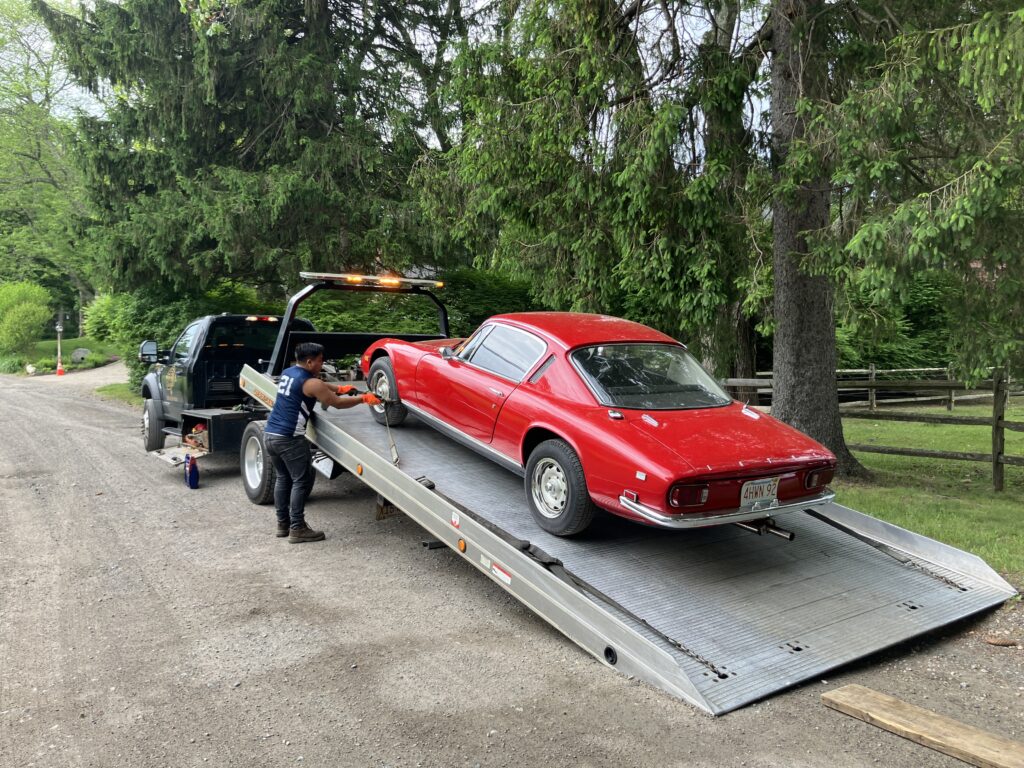
My vintage Lotus being towed. How much more of a caricature of a sports car owner living in an affluent suburb could I be?
When I got the car home, at least it was good enough to repeat the problem in my garage. I used a spare coil-to-distributor wire from a 2002 to check for spark coming from the coil. There was one, but it seemed weak.
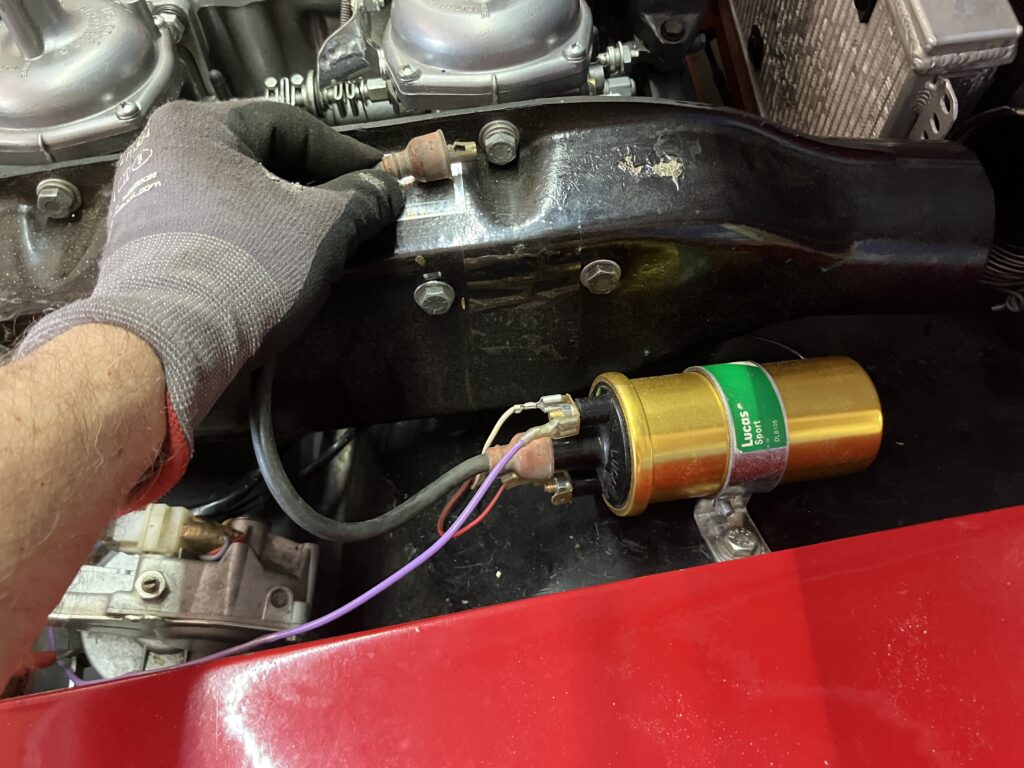
A 2002 coil wire literally tries to breathe the spark of life into the Elan +2, while probably thinking “OH GOD DON’T HOOK ME UP TO A LUCAS COIL!”
I decided to swap parts until I determined the source of the problem. Unfortunately, my Europa with its working-and-thus-known-good Pertronix distributor was in storage in Monson. The Elan’s spare Pertronix was the antithesis of known-good, as it had been removed due to unknown issues prior to my purchase. Fortunately, I found the box in which I’d put the original distributor from the Europa. It was working, though jittery, when I removed it.
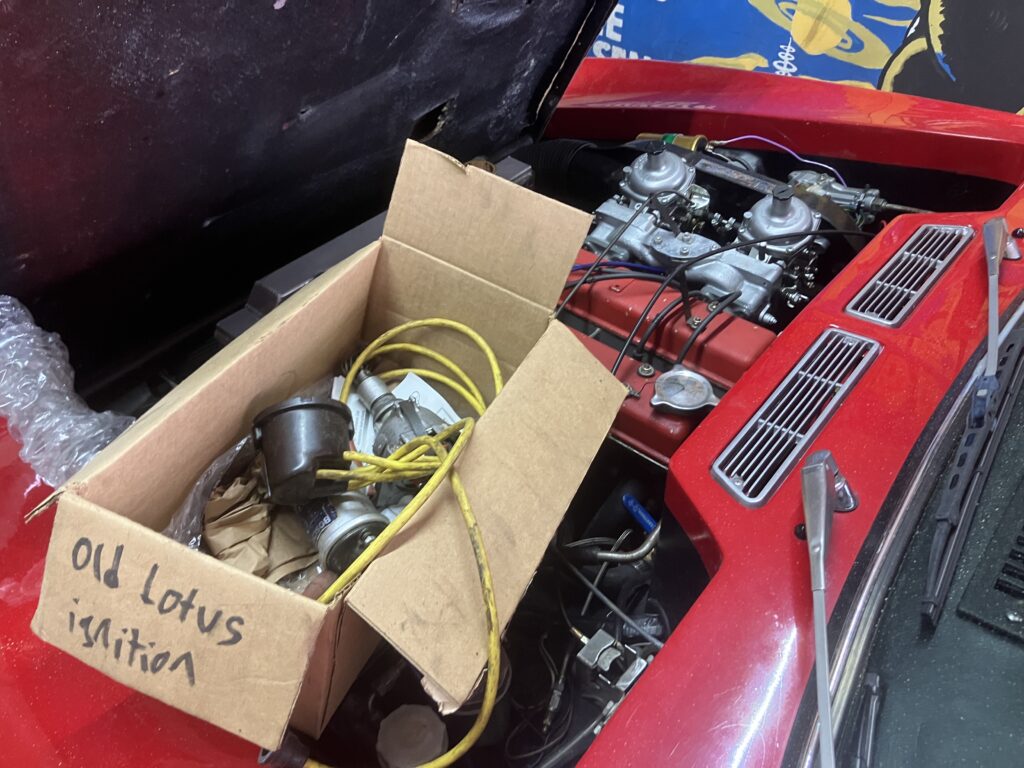
This is why you never throw anything out.
Because getting at the distributor is such a pain, I began with the easiest thing first—replacing the condenser. It made no difference.
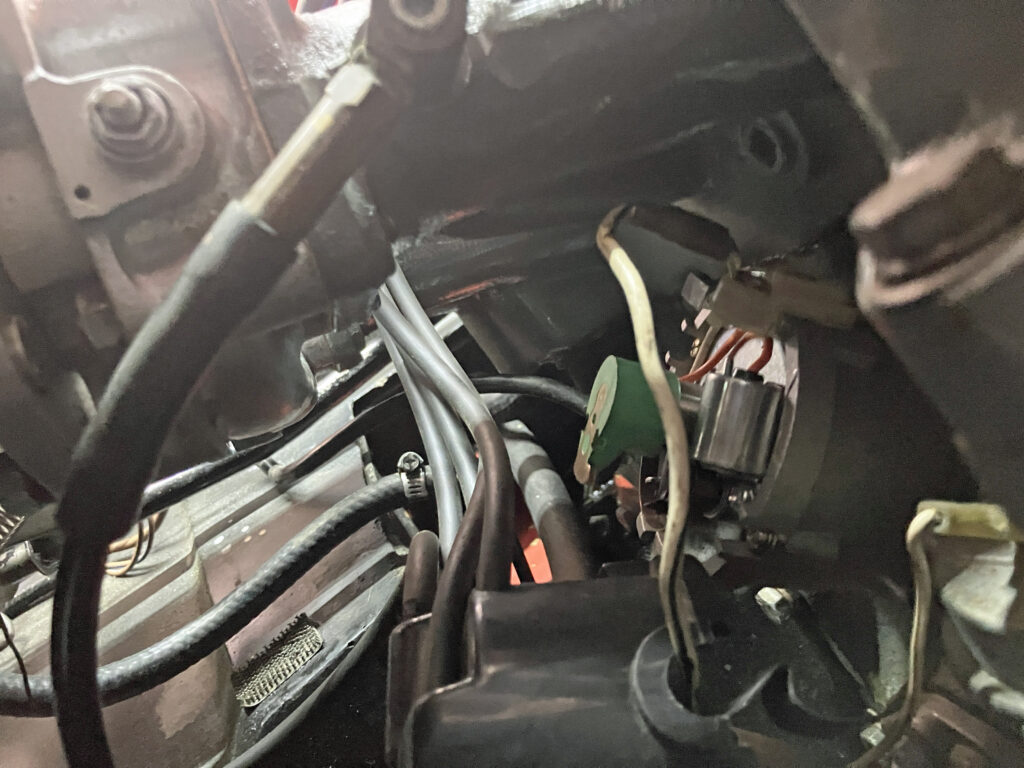
This less-than-perfect pic shows how poor the access is to the Elan’s distributor.
I swapped the cap, rotor, and plug wires, and that didn’t make a difference either. The next logical component to swap was the points. Again, I could visually see them opening and closing, but it was worth a try.
I did, and the car fired right up, and stayed running.
What was going on?
I looked closely at the points I’d removed, and was astonished. One of the point faces wasn’t fully attached to the body of the points. It should be press-fit into a hole, but the press-fit had failed; it was free to just rattle around. You can see it in the photo below, but you can see it better in this video. In addition to being clearly broken, it fit the symptoms perfectly. That is, when the car sat—likely with the points closed—the point face would be pressed back into the hole in the body of the points. But once the car ran for a while, heat and vibration caused the face to again become unsecured, resulting in the points not opening wide enough to allow the coil to fire.

The arrow is pointing to where the point face has broken away from the body holding it, allowing it to rattle around.
The kicker in this was that these were the new points in the new reproduction Lucas distributor that had been installed in the car prior to my purchase. As such, they probably had less than 300 miles on them. The points I replaced them with from the old distributor from my Europa that were in it when I bought the car, which had been sitting in a storage container since 1981, so they were at least 44 years old.
Once I had the Elan +2 running again, I went for the, ahem, extra point, and looked at the Pertronix distributor that had been sitting in a box. I pulled off the cap and looked inside, and the problem was obvious: It was missing the carbon contact that rides on the center of the rotor. I laughed out loud, and remembered the time that I’d gotten a 1985 635CSi for free from my son’s girlfriend’s father because it kept dying on him, his mechanic couldn’t figure out why, and he wanted it gone. I checked for spark, found it leaving the coil but not at the plugs, pulled off the cap, and found a similar problem, except that on that car it was the top of the rotor that was missing the contact, not the cap.
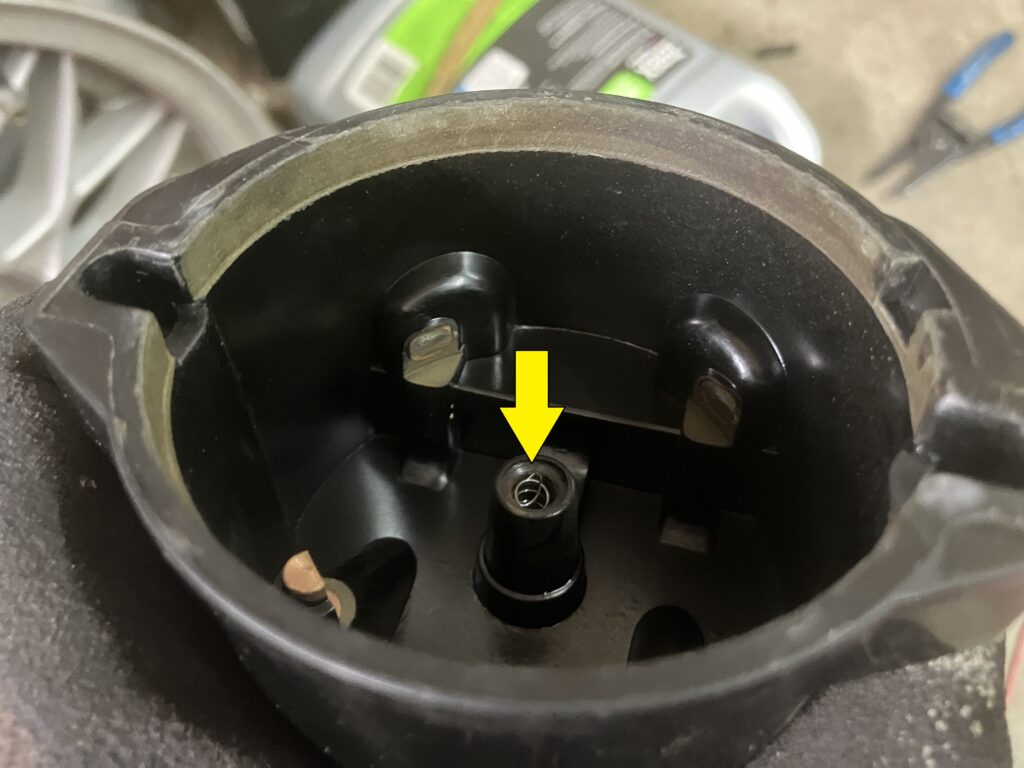
Ha!
I thought that the previous-previous owner (the one who recommissioned the car prior to sale) might be interested in the points-versus-Pertronix saga, so I emailed him. He commended me on my sleuthing, and said something surprising: The fact that the Elan +2 had been sitting for a few years wasn’t because the owner had gotten sick—it was because it had unsolved starting and running issues. One of these was clearly due to the Pertronix’ distributor cap.
Now, I suppose you could rag on Pertronix’ quality control for having the carbon contact break off the distributor cap, but who knows, maybe someone had put it on askew and it caught the side of the rotor. At any rate, with the Pertronix distributor and coil reinstalled, the car starts quite a bit easier, and I no longer need to worry about points breaking off or closing up. And I have a whole known-good spare distributor. Now I only need to worry about all the other issues that come along with owning a 55-year-old Lotus whose name has come to mean “Lots Of Trouble, Usually Serious.”
I do understand wanting to stick with points and condenser in a vintage car. I really do. I’d just strongly recommend that you rely on the ones that are in there, keep the points properly gapped and check them for pitting, and not replace them with new parts as part of a prophylactic “tune-up.” The odds that you’ll be replacing them with something of inferior quality is pretty damned high.
—Rob Siegel
____________________________________
Rob’s latest book, The Best of The Hack Mechanic, is available here on Amazon, as are his seven other books, including Just Needs a Recharge: The Hack Mechanic Guide to Vintage Air Conditioning. Signed copies can be ordered directly from Rob here.
Tags: distributor pertronix points

